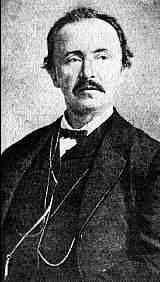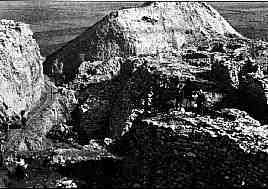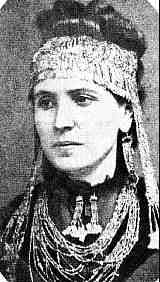

At f ourteen Schliemann was apprenticed to a local grocer. When he hurt his back and could no longer lift heavy weights, he moved to Hamburg. Unable to hold a job there because of his injury, he signed on as a cabin boy on a ship. The ship went down during a bad storm off the coast of Holland. Finding his way to Amsterdam he got a poorly-paying job.
ourteen Schliemann was apprenticed to a local grocer. When he hurt his back and could no longer lift heavy weights, he moved to Hamburg. Unable to hold a job there because of his injury, he signed on as a cabin boy on a ship. The ship went down during a bad storm off the coast of Holland. Finding his way to Amsterdam he got a poorly-paying job.
Schliemann might have stayed in that position for life if he hadn't discovered his knack of learning languages. He taught himself English, Dutch and French. Later he learned Spanish, Portuguese, and Italian. The knowledge of these languages enabled him to find a good position in an import/export firm. He learned Russian and moved to the company's branch office in St. Petersburg in 1846. While there he increased this employer's business while making a small fortune for himself trading in indigo dye.
Now on his way to success ,Schliemann wrote to a friend in Germany and had him pass on a marriage proposal to his childhood sweetheart. He was broken-hearted upon learning she had married someone else a month earlier.
|
Heinrich Schliemann. |
Schliemann (right) traveled to California to inherit a fortune made by his brother in the 1849 gold rush. When he arrived there he discovered the money was gone, but Schliemann managed to double his own funds through the gold dust trade. Schliemann became a naturalized U.S. citizen, but returned to Russian in 1852. He married there, but it didn't work out.
Business was still good, though, and in 1863, at age forty-one, Schliemann retired a millionaire. This permitted him to travel, and he visited the island of Ithaca and Mycenae, the homes of Odysseus and Agamemnon, two of the kings who had fought in the Trojan war. Then he crossed the sea to Turkey to look for the city of Troy itself.
Most historians and archaeologists of the time believed that there never had been a real city of Troy. Of the few that did, most pointed to a hill named Bunarbashi located a few miles inland from the Aegean sea as the location.
Schliemann visited Bunarbashi, but it did not seem right to him. The Iliad mentioned that Mount Ida was visible from the walls of Troy. From Bunarbashi the mountain could not be seen. The Iliad also mentioned that the Greek warrior Achilles chased the Trojan Hector around the walls of the city three times. Bunarbashi had a steep drop on one side that made that impossible. The distance from the sea also seemed wrong. It was eight miles where Schliemann approximated from the text that it should not be more than four.
Using geographic clues from his copy of the Iliad, Schliemann discovered another hill near the village of Hissarlik that seemed to fit the bill. The distance from the sea was right, Mount Ida was visible, and the ground around the outcropping was flat so someone could run around the walls. Schliemann did some checking and found that a couple of other people had come to the same conclusion. In 1822 Charles Maclaren of Scotland published a book claiming Hissarlik as Troy. Frank Calvert, an Englishman living in Turkey, also believed the same thing. Calvert had acquired about half of the hill.
The German was excited, but before he started digging he went to Paris for two years to study archaeology, write a book on Troy and got his Ph.D. from Rostock University in Germany. Before setting out on his dig, Schliemann decided to divorce his current wife and marry another. He wrote to a friend in Greece asking him to locate him a Greek wife. Schliemann wrote that she needed to be young, an orphan, and most importantly a fan of Homer and the Iliad. The friend found seventeen-year-old Sophia Engastromenos. When they met, Schiemann quizzed her on her Homer and she passed. The two were married in Athens. Schiemann had found his own Helen.
A firman, or agreement, was obtained from the Turkish government that would allow Schliemann to dig at Hissarlik. The agreement stated that any treasure found must be divided with the government. Excavations started in 1871 with seventy local workers. Schliemann sunk shafts and trenches into the hillside. What he discovered was not the ruin of a city, but the remains of eleven cities, each one built on the ruins of the earlier settlements.
|
The dig at Hissarlik. |
The bottom-most city, which is referred to as Tory I, Schliemann thought must have been destroyed by an earthquake because of the cracks in the foundations. Since the Greeks had destroyed the city with fire according to Homer, this could not be the remains of the city mentioned in the Iliad. Troy II, the next layer up, had been burned. Schliemann decided that this must be the Troy of Homer's tale. The next season he hired 160 men to dig down to this layer of the hill. Scientific archaeology had not really come of age yet and unfortunately this work destroyed much of the later history of the city (right).
The main objective of Schliemann's work was to find what he called "Priam's treasure." According to Homer, Priam ruled the city of Troy during the war. Schliemann felt sure that the King must have hidden his treasure somewhere in the city to avoid its capture by the Greeks should they win the battle.
In May or June of 1873, Schliemann and Sophia were out at the site watching the digging when Schliemann's eye caught site of a glint of copper coming from the side of one of the shafts. Climbing down, he realized he was looking at a copper jug embedded in the wall. There was a hole in the jug and he could see gold inside. Telling his wife to send the workers on a break, Schliemann used his knife to dig in the wall and free the jug. Sophia soon joined him and they both shared in the discovery.
"While the men were resting and eating," he later wrote, "I cut out the Treasure with a large knife. This required great exertion and involved great risk, since the wall of the fortification beneath which I had to dig threatened every moment to fall on me. But the sight of so many objects, every one of which is of inestimable value to archaeology, made me reckless. I never thought of any danger."
|
The golden earrings and necklaces fournd in Troy worn by Sophia Schliemann. |
The treasure included golden earrings, necklaces, pots of silver and gold and other items. The most impressive of these were two gold diadems that might have been worn by a queen or princess. The treasure was smuggled back to Schliemann's home and then out of the country.
The Turkish government was not amused and sued Schliemann. They won a $5,000 judgment. Schliemann at first refused to pay, but then relented and gave the Turkish government five times the actual value of the fine. The Turks decided to allow Schliemann to again dig at Troy, but this time they would watch him like a hawk.
Schliemann decided to start another dig at Mycenae in Greece which had been the home of Agamemnon, leader of the Greeks that had attacked Troy. The city had lay in ruins since 468 B.C.. Unlike Troy, the location was well-known. Schliemann cleared the gate of the city and then started digging within a strange circle of stones inside the entrance. He found 19 graves and a treasure of grave goods worth more than the cache at Troy. One of them was a golden death mask (see top of page). Thinking he had found the grave of the king Schliemann said, "I have gazed on the face of Agamemnon!"
Despite all his luck at finding treasure, Schliemann was consistently wrong on his facts. Later archaeologists would date the treasure at Mycenae as being two hundred years before the time of Agamemnon and the treasure of Troy over a thousand years before Homer's Trojan War. In 1878 Schliemann returned to Troy and discovered two additional small treasure troves. In 1879 he took on an assistant, Wilhelm Dorpfeld. Dorpfeld would continue the work on Troy after Schliemann died, deciding that Troy VI was really the city of Homer's poem.
Dorpfeld would later change his mind when Carl Blegan examined the site in 1932. Blegan unearthed convincing evidence that Troy VII-a was the Homeric city. Dorpfeld, in his eighties by that time, came to agree with him.
In 1880 Schliemann, who was growing old by then, decided he needed to find a permanent home for the Treasure of Troy. He donated it to a museum in Berlin, Germany. It disappeared during WWII seized by Russian soldiers, and now resides in the Pushkin Museum in Russia.
Yes, Schliemann was very lucky. Recently some historians are asking if perhaps he was too lucky. Several incidents Schliemann wrote about in his life have turned out to be fabrications. This has made some archaeologists wonder if some of the treasure he found were actually modern forgeries planted to enhance his own reputation. Even the wonderful, but incorrectly named, "Mask of Agamemnon" has come under scrutiny. Did Schliemann fake it? Or at least alter it to appear more dramatic? For the time being the nobody has proved these things a fake and despite some falsehoods in his writings his claim that he found the city of Troy still stands.
As for Troy itself, many archaeological mysteries remain. Studies show that the people who built the first Troy were not the same people who later lived there during the Trojan War. Who were these early people and what became of them? Homer's poem suggests that the war was over the kidnaping of a Greek king's wife. It's hard to believe that the Greeks fought a ten-year war over one woman. What was the real reason for the hostilities? Legend has it that Troy fell when the Greeks built a wooden horse, filled it with soldiers and the unsuspecting Trojan's rolled it into the city. Is this true?
These questions remain as challenges to future archaeologists that would dig for treasures at the ancient city of Troy.







0 comments:
Post a Comment